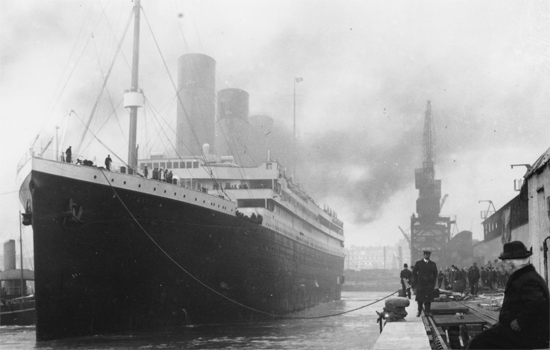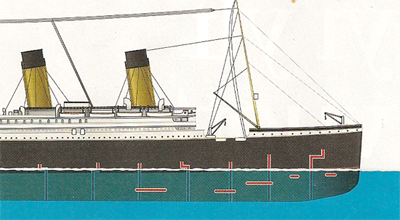R.M.S Titanic
Titanic was the biggest ship ever made. But what happened?

A real photo of Titanic.
Titanic was built by Harland & Wolff for White Star Line. At its time it was the largest man-built thing ever made. Before Titanic, Cunard-line, White Star Line's arch competitor had built the Lusitania. It was 241 meters long and carried the title of the largest ever built construction.
Year 1907 J. Bruce Ismay, the head of White Star Line had to come up with something revolutionary to blast off the Lusitania. He imagined the biggest and most luxurious ship, the Titanic. Titanic had two sister vessels, R.M.S Olympic and R.M.S Gigantic, which was later named to R.M.S Britannic.
On April 10 1912 Titanic was set off for its maiden voyage. During the voyage Titanic received multiple iceberg warnings, and most of them the captain Edward J. Smith never got to know of, because the crew didn't want to disturb him as he was busy hosting a dinner the day before the Titanic struck the iceberg.
C.Q.D & S.O.S
C.Q.D was the emergency call Titanic used as soon as they found out the ship was sinking. C.Q.D is short for Come Quick, Danger. S.O.S was a new call and it was used for the first time ever by Titanic. S.O.S is short for Save Our Souls.
Jack Phillips was the telegraphist on Titanic and was in charge of the telegraphs. The first emergency call from Titanic was sent at 0:15. Jack sent the last message at 2:17, just as the ship broke in half.
The sinking
Titanic was called unsinkable, but that was neither a marketing trick nor a joke. The title came from the bulkhead system, which was supposed to prevent the water from flooding the whole ship. The first four compartments
were equipped with bulkheads that were well above the water line. However, the bulkheads from the fifth compartment onwards weren't that high and so there was nothing stopping the water from flooding
to the rest of the ship, thus sinking the whole beauty.

The bulkheads and the spots of the holes
Image copyright © Ilta-Sanomat/Titanic-magazine
The truth about the cause
Unlike people believed for long, the Titanic didn't struck the iceberg because of a slow reaction, or the absence of the binoculars. No, the reason was that
starboard and port had been lately changed places.
That means if port meant right before, and now it meant left, the coxswain mixed them, and fatally turned the ship to the wrong direction at first. He quickly corrected it, but it was already too late.
Only after he died, his wife told the truth. This of course assuming that she was telling the truth.
A documentary called "Titanic's final mystery" investigates the weather circumstances the Titanic had on the night of its sinking.
The first lifeboat was lowered not until 0:45, and onboard it there were only a few crew members and some 1st class passengers.
Unlike people believed for long, the iceberg didn't rip big holes to the body of the Titanic. The frozen water wasn't strong enough to break through the 2.54 cm steel body. It was strong enough to bend the steel plates however, which led to the rivets rocketing out of their places and leaving holes the size of a man's finger to the body. Small holes, but fatal. The water ran through the holes at a rate of 7000 liters per second. Only after 20 minutes 8 million liters of water had already flowed in to the ship, and the passengers could feel as if they were walking down hill.
As the amount of water increased inside the ship, the front went down below the surface of the sea. With the front end of the ship full of water, the rear side raised upwards while the front was sinking, a great amount of mass centered to the body. The body of course wasn't designed to be able to cope with a weight of around 20 000 tons led to it breaking in half. At the same time the steam boilers exploded and accompanied the breaking with a stunning sound.
After the front and rear parts of the ship had detached, the rear part was left floating on the water for a while. The water was pushing the air out of the rear part, and soon it started sinking too, pulling everyone on it underneath the water. Only about 3 minutes after the telegraphist stopped sending messages the whole ship had sunken.
Passengers
On board the ship was a total of 2200 passengers. Only 675, mostly women and children survived. 1525 lives were lost.
At the time people were in different classes on the ship, defined by the financial standing of each passenger. 1st class, 2nd class and the 3rd class. This class system also defined who survived the accident.
Survivors from each class
1ST CLASS:
62% of 1st class passengers were saved.
2ND CLASS:
42% of 2nd class passengers were saved.
3RD CLASS:
Only 25% of 3rd class passengers were saved.
The body of the ship
Later in investigations it has been found out that Thomas Andrews, the designer of Titanic, wanted the steel plates to be 3.17 cm, thicker than the regular thickness of 2.54 cm, which was required by the law. Despite this, the owner of White Star Line, J. Bruce Ismay ordered the builders to use thinner steel, and therefore the ship would require 25 tons less coal per day. This was another reason leading to the sinking.
The Titanic explorers brought a piece of Titanic's steel above the surface of the sea for examination. In the university of Missouri, during examination with an electromicroscope it was found out that the steel which was used in the Titanic had a lot of sulfur impurity. This was partly making the ship's construction weaker, leading to easier bending of the steel plates. A researcher from the university said that today he wouldn't let anyone build a ship using this kind of steel.
- The steel at the time was the best they could possibly have, said David Livingstone, a Harland & Wolff engineer.
At the night of the sinking, the temperature was unusually low. Combined with the freezing cold water, the brittle steel of Titanic perished even more. Tests show that up to 95% of the sunken ship's steel had fractures.
___________________
NIKO May 16 2012
Updated on November 5 2015Sources: Ilta-Sanomat Titanic-magazine & my own knowledge from other sources

 Nikosite
Nikosite